Savioke, who’ve just raised a $15M Series A round for their hotel delivery robot, feature in the recent Silicon Valley Robotics Service Robotics Case Studies. Savioke are now deployed in five hotel chains, have completed 12,000 successful deliveries and have an NSF grant to explore other applications for their robots, like eldercare.
Savioke is creating autonomous robots for the services industry. The company aims to improve the lives of people by developing and deploying robotic technology in human environments. Savioke was founded in 2013 and is headquartered in Santa Clara, CA. Savioke is the creator of Relay, state-of-the-art robot designed for autonomous delivery of items between people. Relay’s first application is in the hospitality industry.
Relay delivers snacks and amenities to hotel guests, enabling hotel staff to focus on other guests’ needs. With successful deployments in the U.S. at hotel groups such as Starwood and InterContinental Group, Relay has a proven record of more than twelve thousand deliveries [as of 1/10/16]. Savioke (pronounced “savvy oak”) was awarded a GameChanger award by Robotics Business Review for Best Consumer Solution.
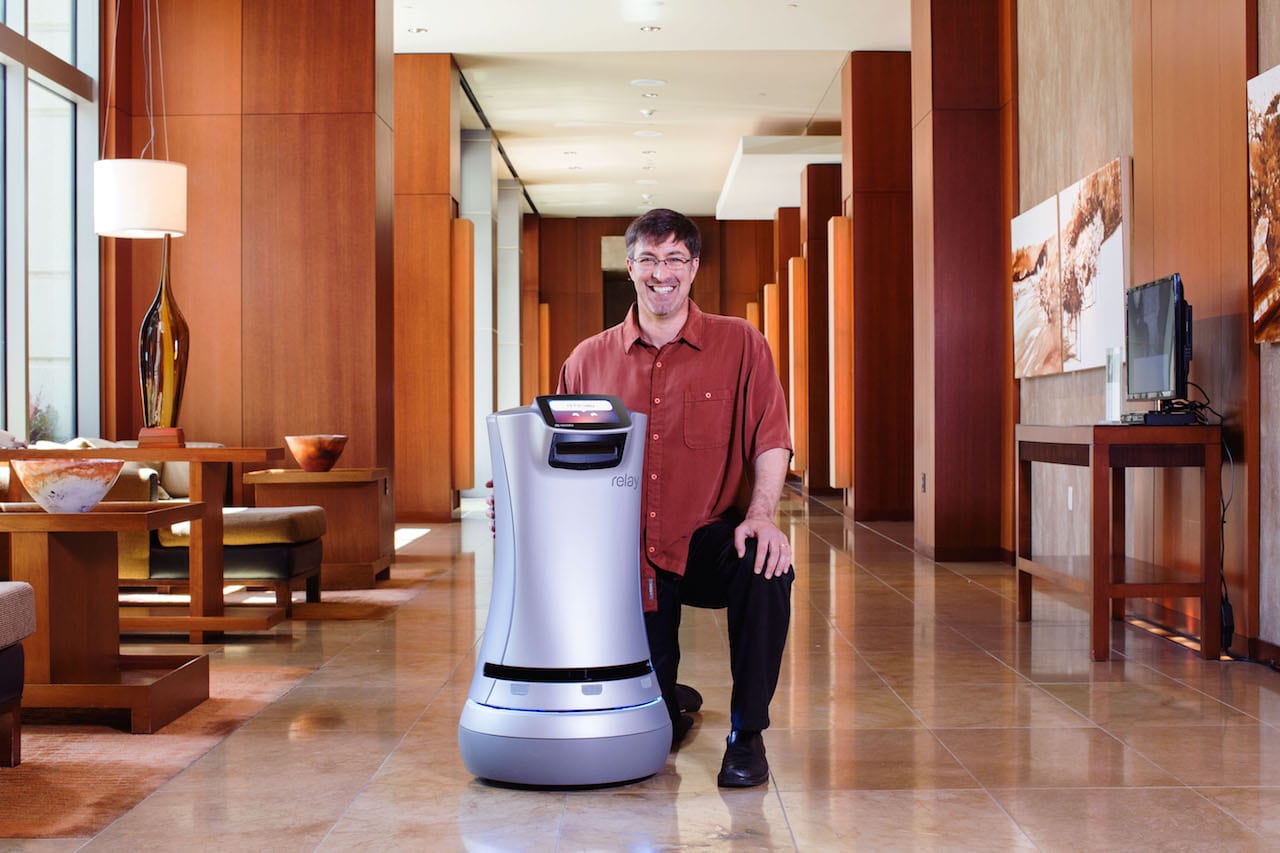
Interview with Steve Cousins, CEO Savioke edited for clarity
Can you describe the value proposition of Relay?
In a nutshell, what Relay does is let the hotel staff increase the service level at the hotel, and increase the productivity of hotel workers by having Relay handle simple room delivery. The robot is leased to hotels as a service.
How did you select hotels as your alpha customers?
We looked broadly at a lot of industries while some of us were still at Willow Garage, anywhere from manufacturing to the home. Manufacturing is interesting, for example, but already well served by robotics. The home is unstructured and complicated, along with very tight price targets. Of the industries in the middle, we thought the service industry was a pretty interesting place to go. You have repeating tasks. In many cases you have semi-structured environments. You have a lot of human labor doing tasks that are very repetitive.
We then looked industry by industry within the service sector to see how we might go to market, and how our product might fit. After an extensive analysis, we decided that hotels were the best place to start.
In the industry itself, how did you select your alpha customers?
One of our early VC friends told us that we needed more hotel contacts if we were going to make a go of this business. We asked him if he had any and he said he didn’t but he suggested that we start cold calling at hotels. So that’s what we did. We just went to the general manager of each hotel. Because it’s the hospitality industry, the general manager will always come out and talk to you. We simply asked them for 10 minutes of their time, told them what we had in mind, and asked if they might be interested.
And in the end, we kicked off our alpha program with the Aloft in Cupertino. They immediately understood the benefit of Relay and connected us to their corporate base. We then had contacts at both the individual hotels and Starwood corporate, which gave us a really nice platform. In the hospitality industry it’s very useful to have both a brand advocate as well as a hotel advocate.
How many deployments do you have and how long have trials been underway?
We are now in four hotels and rapidly signing up more. We’ve been in the first hotel for almost a year (recorded July 2015). We’ve been in that one plus the second Aloft since March. Relay can now be found in the Crowne Plaza Silicon Valley/San Jose, the Holiday Inn Express in Redwood City, the Grand Hotel in Sunnyvale, CA and a Marriot in Los Angeles.
So we are in two Starwood hotels, and they also use a third robot as a travelling brand ambassador. We are also now going into multiple chains.
Are you finding similarities or differences between hotels and chains?
When you do something for the first time in a pilot, you learn a ton. And when you go to the second one, you find out what was common and what’s new. What we found in the second hotel were little things, like the size of the map was significantly larger and we had to deal with that issue. The elevators were a lot faster, and that was a good thing. The Wi-Fi situation and the LTE coverage situation were really different. Every hotel that we go into we learn some new stuff, some new corner case or some new issue. The number of issues is going down though.
The second hotel came up a lot faster than we expected, to be honest. We find a couple of issues, we fix them and we go. The fourth hotel was almost no problems at all. So it’s interesting.
This is a robot that works alongside people. So in addition to the technology, you have to teach the people what they can expect of it. How to work it. How to understand what it does. How to not be threatened by it. In the end, it’s people using the robot to do work, so they have to be willing and able to use it.
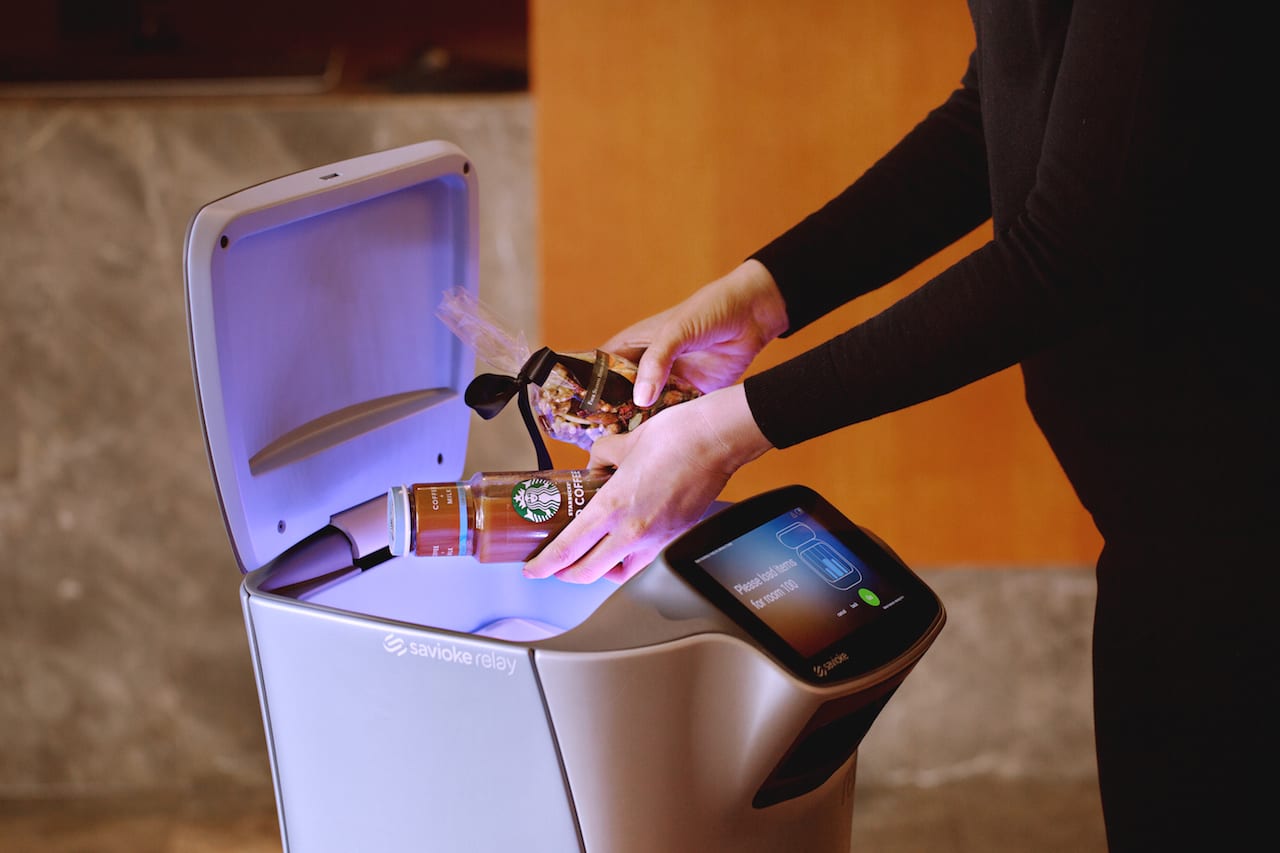
Can you describe Relay?
Relay is a delivery robot. It’s not dissimilar to R2D2. It has a lid on the top that locks and it can open itself. It has some sensors on the front, and is designed to move through human spaces, not hit anybody, not hit anything, not get lost, ride the elevators and move gracefully around people. It has a locking bin, where front desk staff can put something in it, key in a room number, and let Relay make the room delivery. Those are the core capabilities.
In a typical scenario, somebody calls the front desk and says, can I have a couple of extra towels? The front desk puts the towels inside of Relay, types in the room number and sends it off.
The robot navigates to the elevator, rides up to your floor, gets off and navigates to your door, calls your room. When a guest answers the phone it says “There’s a robot outside the door with your delivery”.
When the guest opens their door, Relay automatically opens its lid, and the guests get their towels. Relay actually hangs around for a few seconds so guests can interact with it. It asks you a question, “How is your stay going?” and then it leaves and goes back to its dock.
What can Relay carry?
The compartment is almost 1 foot by 1 foot by 14 inches deep and has a deep bin. It can carry whatever can fit inside it up to about 10 lbs. It’s not designed to be a workhorse or carry luggage, but rather for small items; amenities; a bag of food.
Would a hotel use one or several units?
It depends on the hotel and how they use it. In the first hotels we are deploying a single robot to start. We’ve recently signed up our first hotel that will take two robots. Most hotels the average size of hotel is around 150 rooms, which you might be able to get away with one Relay in. But there’s a lot of opportunities to use the robot to increase service. As hotels discover those, they may find that they need additional robots to handle new services or increased demand.
Are these unique services that have never previously been available or is it the volume, that the hotel can provide more services?
It could be either. A good example is a lot of hotels limit room service to certain hours of the day. Also, a lot of hotels have only one person on staff on the front desk overnight, in which case they can’t leave the front desk and be going out and doing deliveries. This is true in a few of our hotels where we find that Relay is regularly doing 3am deliveries. Because the hotel can now offer that sort of service, so they do.
But it takes a while for people to get used to the fact that they can order something at 3am or 2am if they want to. And if you think about the logistics of it, usually there’s something in your room that tells you all the services the hotel provides. And as you get the robot, those things need to get updated and the hotel has to get comfortable with how often they’re going to use it and what they’re going to offer with it.
There are other kinds of services, as well. The first case is a timing of deliveries. There’s other kinds of services that hotels used to do but don’t do anymore, probably due to labor costs and the fact that they have to cut back in order to stay within their budget, things like shoe shines and laundry. Of course, hotels mostly have laundry services these days but with Relay you can call for the robot to come with the laundry bag, put your stuff in the bag right there, send that back down to the desk, get it washed and delivered back to your room. Instead of thinking about “Do I have to wear my pajamas down to the laundry room?’, you can get it taken care of without having to leave your room.
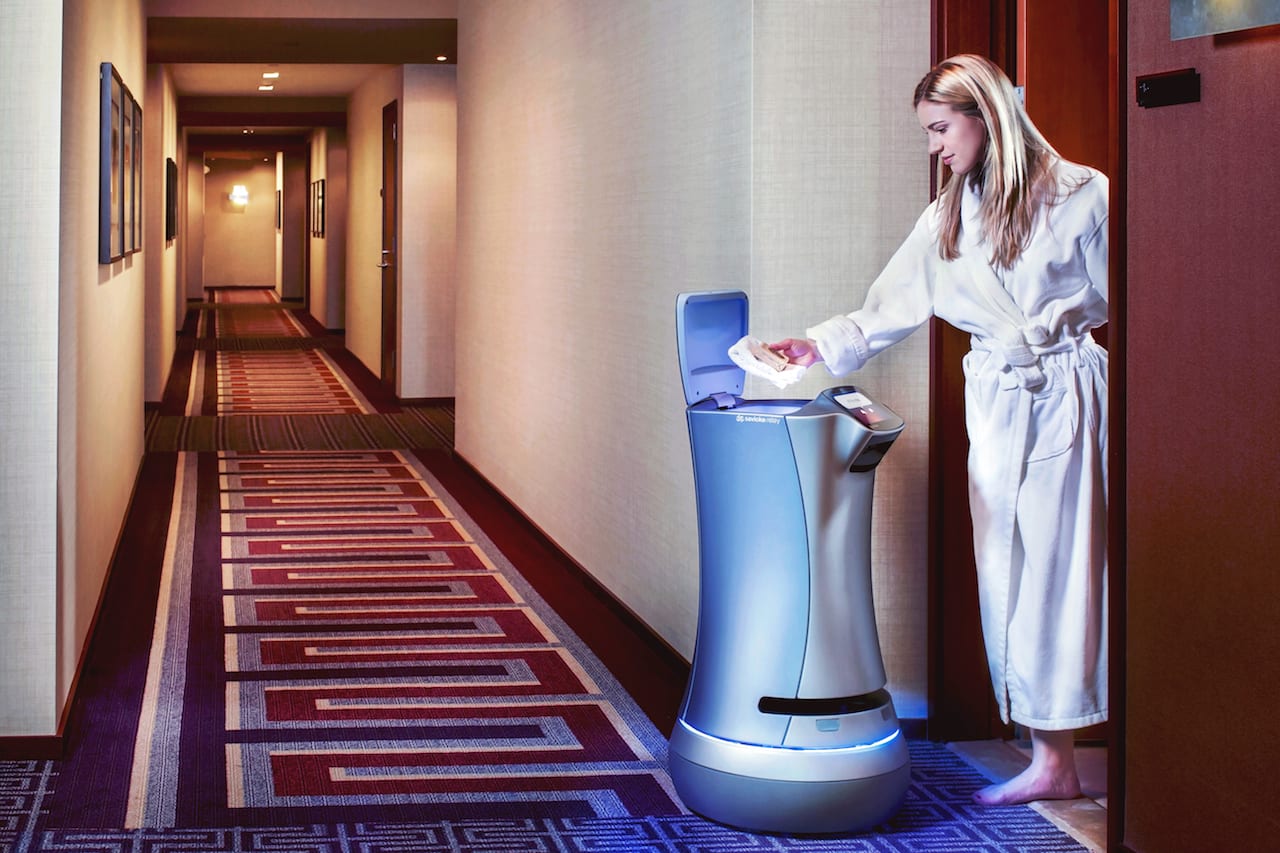
Is Relay replacing a human? How does Relay fit in to the existing labor force in a hotel?
Relay is not designed to replace people. It’s designed to be a productivity aid for the people who are already there. When you look at what a person at the front desk is doing, they do a lot of different things. Relay can’t do all the things that they’re doing but some of the times they’ll do is run off and do a delivery. That’s really kind of menial work for that person. Our position is that you want people doing things that they’re skilled enough to do and that way we take advantage of all the great things about being a human. And you want the boring repetitive and redundant tasks being done by a robot.
No one ever writes on their resume that they know how to ride the elevator all by themselves. Right? While it’s a pretty cool skill for a robot, it’s not worth mentioning for a person. So why should you pay a person $15/hour to do that sort of work? You stand there and you wait and you ride. And you’re not getting anything truly productive done.
Relay is like any other tool right? You don’t need power nailers, for example. You could have workers hammering away all day, and then deal with the repetitive stress injury that comes with that job, like roofers and such. But someone invented power nailers, so people can work faster, they can do more roofs. The idea is not that we’re trying to put roofers out of work. We’re trying to make them more productive and that’s how we think about Relay.
What’s the ROI? At $15/hour, most people believe it’s still more affordable to hire people rather than robots to do these boring, repetitive and potentially injurious tasks.
They haven’t compared the costs to Relay. Basically, look at what Relay costs per hour and it’s clear that it’s cheaper. We’re making Relay available to hotels on a monthly basis. We call it Robots as a Service, and it is less expensive than a person would be for a shift. So it’s not that you’re paying more for this robot, you’re paying less.
What makes Relay so affordable now? Is it a confluence of technological improvements and other factors?
I think it is a confluence of factors. We’ve seen sensors come down in price. We’ve seen computational power come down in price. We’ve seen our ability to prototype get much, much better with all of these new maker tools. It’s not that we want to 3D print all robots in construction but in order to get a standing start it helps to have all these tools available, until you actually have that robot in production.
I think the other big piece is ROS, the robot operating system that was grown at Willow Garage and is now supported by the Open Source Robotics Foundation. It gives you a big leg up in terms of being able to get things going sooner.
It’s not that ROS does everything perfectly for a production product but it gives you a head start.
That combined with all the other relatively low cost technologies that you can combine, makes it possible to make a low-cost robot that you can afford to deploy.
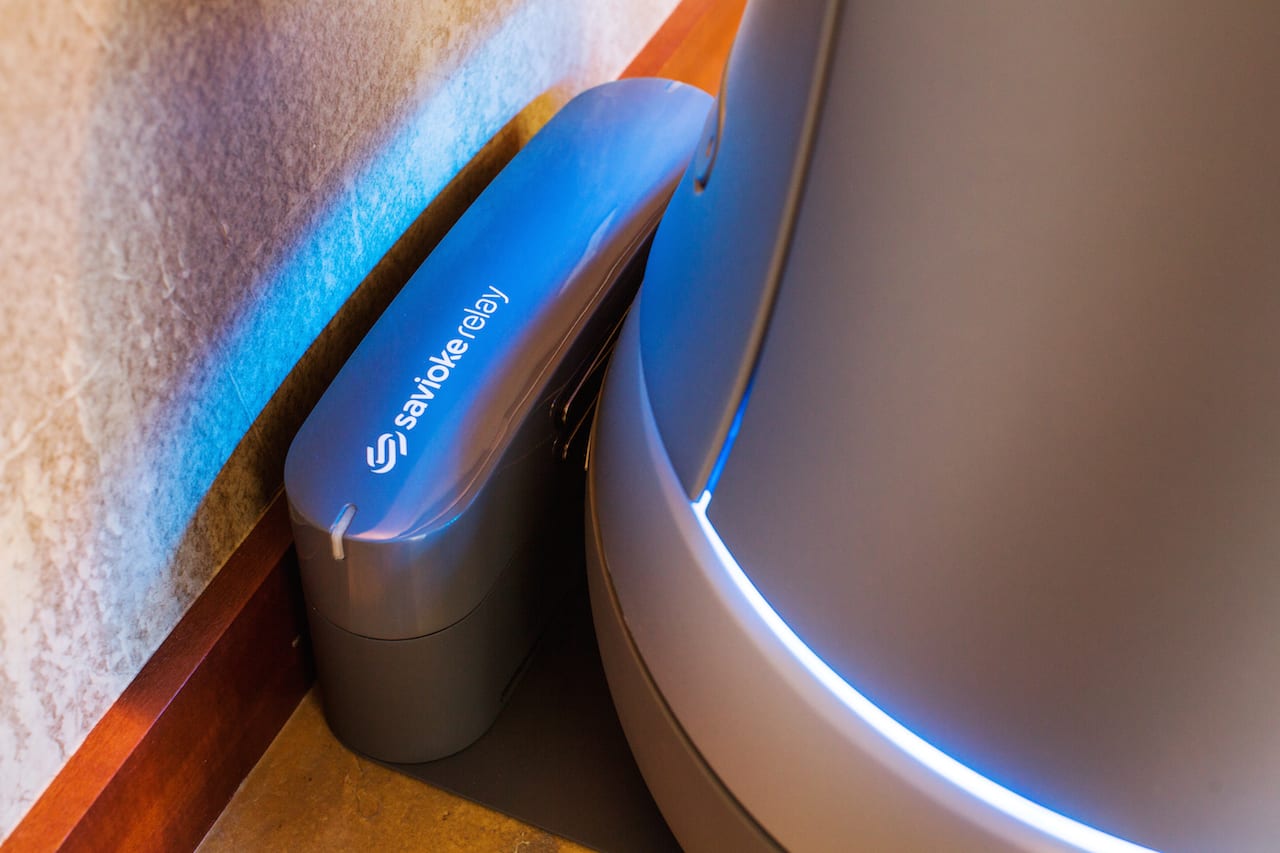
Have there been other successful service robots in the past or is this a new paradigm? (Joe Engelberger pioneered both industrial robotics and then service robotics in the 90s with the first hospital delivery robots)
Ask yourself, how many delivery robots have you seen in your life and where did you see them? If you’ve seen any then it’s probably been hospital delivery robots or office mail delivery robots. In the case of office mail delivery robots, those are technologies that are more than 20 or 25 years old. It basically follows a path and if someone gets in the way it just stops and then continues on. The robots that are in hospitals are doing a good job. They carry large loads. They tend to follow a fixed path and stop. Kind of like a freight train.
And what we’ve done is said, “That’s a really interesting model but what if we could build, not a freight train, but a FedEx delivery truck?” Something that could go from point A to point B and can do the kind of deliveries that we’ve all come to expect, with Google Express and Amazon Now and all these modern 21st century technologies. Why can’t we have that same thing inside of our commercial buildings?
That’s what we went for, and when you dive into the details of earlier service robots, we’re built on much more modern technologies and at a lower cost, because we can use modern technologies.
What has the response been to Relay?
Guests love it. You’ll need to use special characters to type this, but this guy answers the door, and early on we were waiting in the corners so that we wouldn’t interfere with the delivery. And the robot shows up at his door and he says, “Holy Shit!!!” He was so excited. And kids opening the door… “Mum, Mum! There’s a robot at the door!” And there’ve been girls hanging out of the door with their cameras, following it down the hall. The delight is palpable.
There’s always a naysayers, but they’ve been very very rare. Mostly you see people, they get their delivery and they smile. The robot always says “How did I do?” or “How was your stay?”. Guests usually give five stars. The robot makes a little happy dance and they smile again and the robot goes away.
You see this in all sorts of different ways. Look on TripAdvisor and you can look on Twitter. People are experiencing this thing and enjoying it. And the “at the door” experience is just fundamentally different than if somebody brings you what you ask for. If you call down for a couple of towels, a persons going to show up at your door and you’re not going to be sure whether to tip them or not, because you’re not buying anything, they’re just towels. Or say they bring you a toothbrush. Are you going to tip them $2.00 for a 25 cent toothbrush?
I can’t tell you how many people comment, “This is great, I love it, I don’t have to tip it.” Another thing is you don’t have to get dressed for it. If the robot’s coming and bringing you something early in the morning, you don’t have to brush your teeth and get dressed because there’s a person coming to your door. Robots don’t care how you look and they don’t smell your breath. It’s just a more “at the door” experience that people seem to like.
We’ve also found that the hotel staff loves Relay as well. Part of the reason hotel staff are working in that industry is because they like to make people happy. So if the robot makes people happy, they’re happy. It also appeals to their efficiency. It’s a pain to go deliver something to a room when you’re the only one in the building, or when you’ve got other stuff you need to be working on. Whether it’s sitting at the front desk in the middle of the night reading your book or whether you’ve got three more people to check in, it can be annoying or stressful, if you’re rushing to get back.
Instead, staff can just give this thing to Relay and it takes care of the task. Simple. And it gets the task done without you having to spend the nearly ten minutes that it would take to do that work.
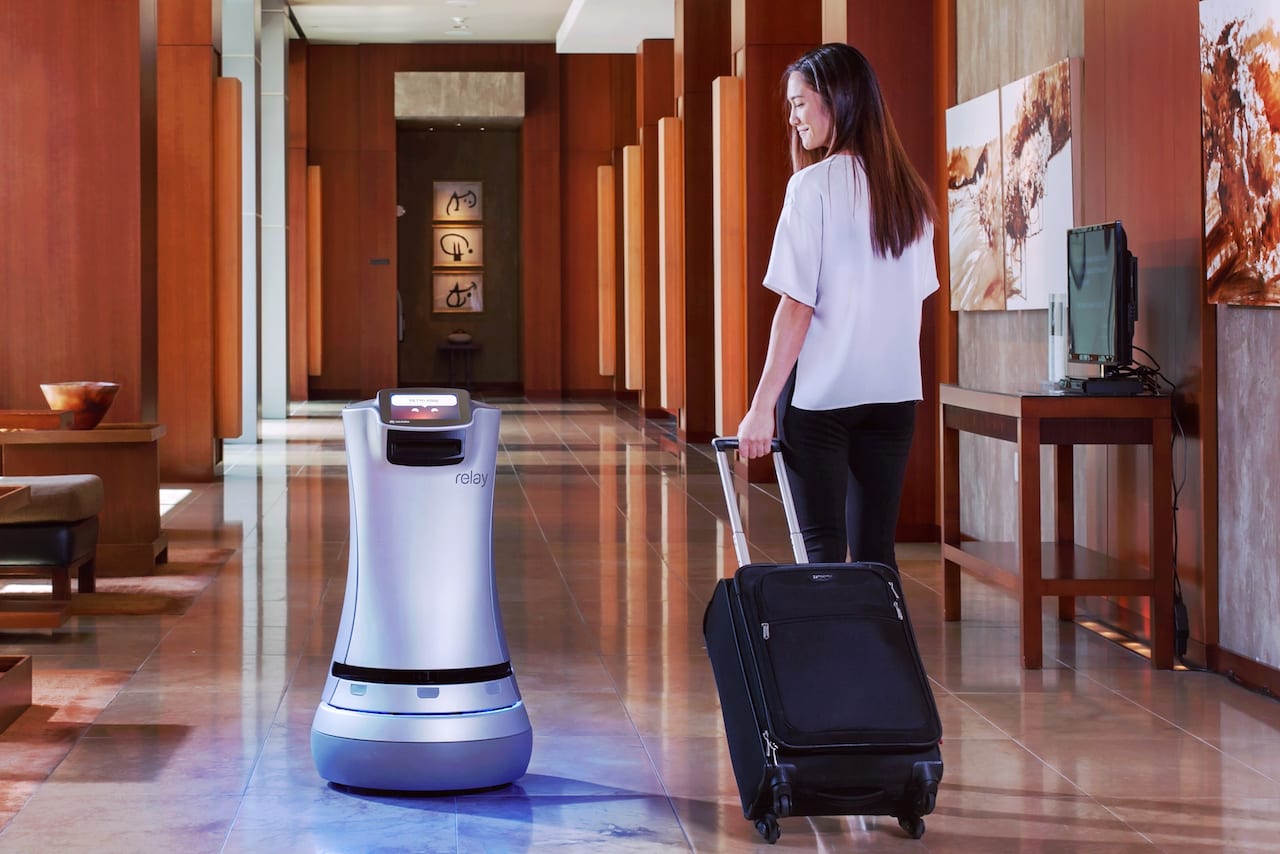
Were you expecting this behavior, or have you evolved the behaviors of your robot in response?
We designed Relay to be attractive. We didn’t want it to be industrial or scary. I think we were surprised by the level to which people loved it and in response we’ve been playing up some of those things. As we refine it, we take that into account and we try to make it a little bit nicer, a little bit friendlier. And that becomes a core piece of the product.
What metrics are you collecting? How does staff know that the robot is performing well?
They can see the guests in the lobby, so they can see people are happy when the robot passes them in the lobby. They know it does the delivery because they have a monitoring tool that we give them that let’s them see where the robot is at any given time. It’s not unlike Uber. There is transparency as to where the robot is and what it’s doing. If they send the robot to Room 243 and then realize it was supposed to be room 234, they can just cancel it and redirect it to correct room without any problem. The staff can correct those sorts of errors and recall the robot and basically they have control over it remotely. Basically, it’s a tool that they’re using to get that work done.
What do you see as the future potential for Relay? Where would you like to see Relay deployed next?
Everywhere.
Any specific commercial realms?
We’ve had a lot of people call to ask us if they can use Relay for this service or that function. We’re trying to stay focused on the service industry. There are certainly opportunities in logistics for delivery robots and in manufacturing. But there are already variations of autonomous guided vehicles in those spaces. We’ve hit a different sweet spot. We offer a robot that can safely be around kids and people. We just basically try to mix right in to the human environment.
But in terms of pushing forward, we’re focused on hotels first, because you have to be focused in a startup. Also, different environments have different requirements and new engineering issues. For example, we took Relay to the last Golden State Warriors home game of the season and had it deliver to luxury boxes. Normally Relay arrives at the hotel room and phones the room. But if you call a luxury box in the middle of the game though, they probably won’t hear the phone. It’s very loud inside Oracle Arena, especially at the Warriors games. So we would have to devise a different way to signal the room occupants that their delivery has arrived.
That’s the kind of scenario that we would examine to see if this technology fits or if we could adapt it. If there’s a big enough opportunity, then we will.
And in conclusion?
The thing that we’ve learned, and has been reinforced over and over, is the notion that a startup has to focus. The more Savioke focuses on a single task, the more successful we will be at handling all the little details correctly. That’s what we’ve been trying to do. That’s why we’re starting in hotels and staying there for the most part. We’ll focus on hospitality until we feel like we’ve really got it and then we’ll see how we can expand from there.
The rest of our free report is AVAILABLE HERE — or in instalments at Silicon Valley Robotics — featuring case studies and analysis from industry experts and investors; OATV, Citrix Startup Accelerator and Konica Minolta Business Innovation Center.
